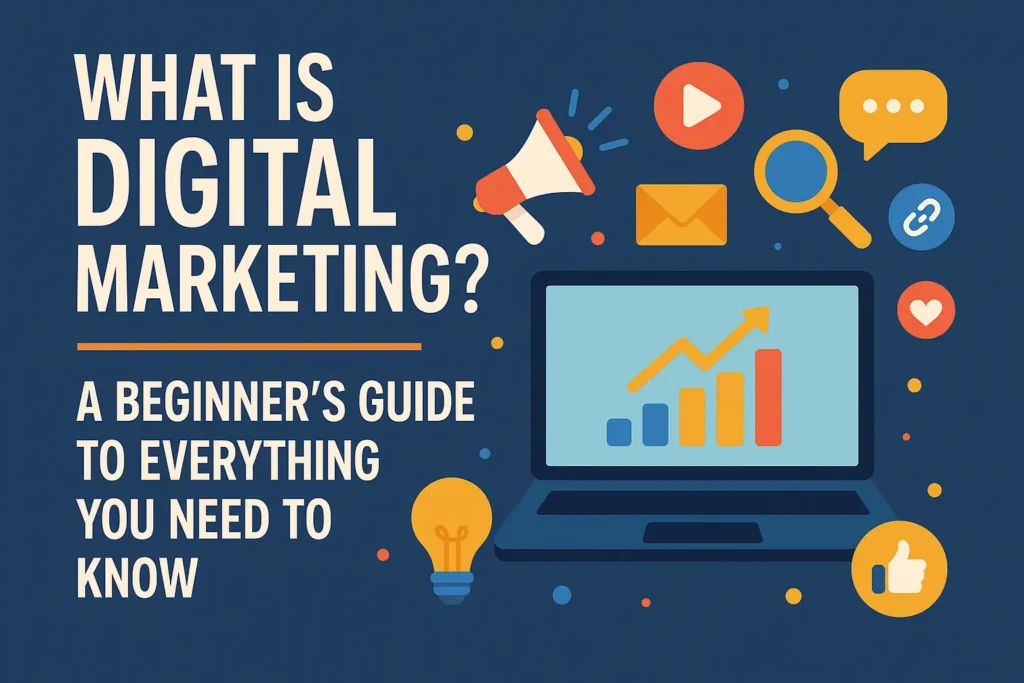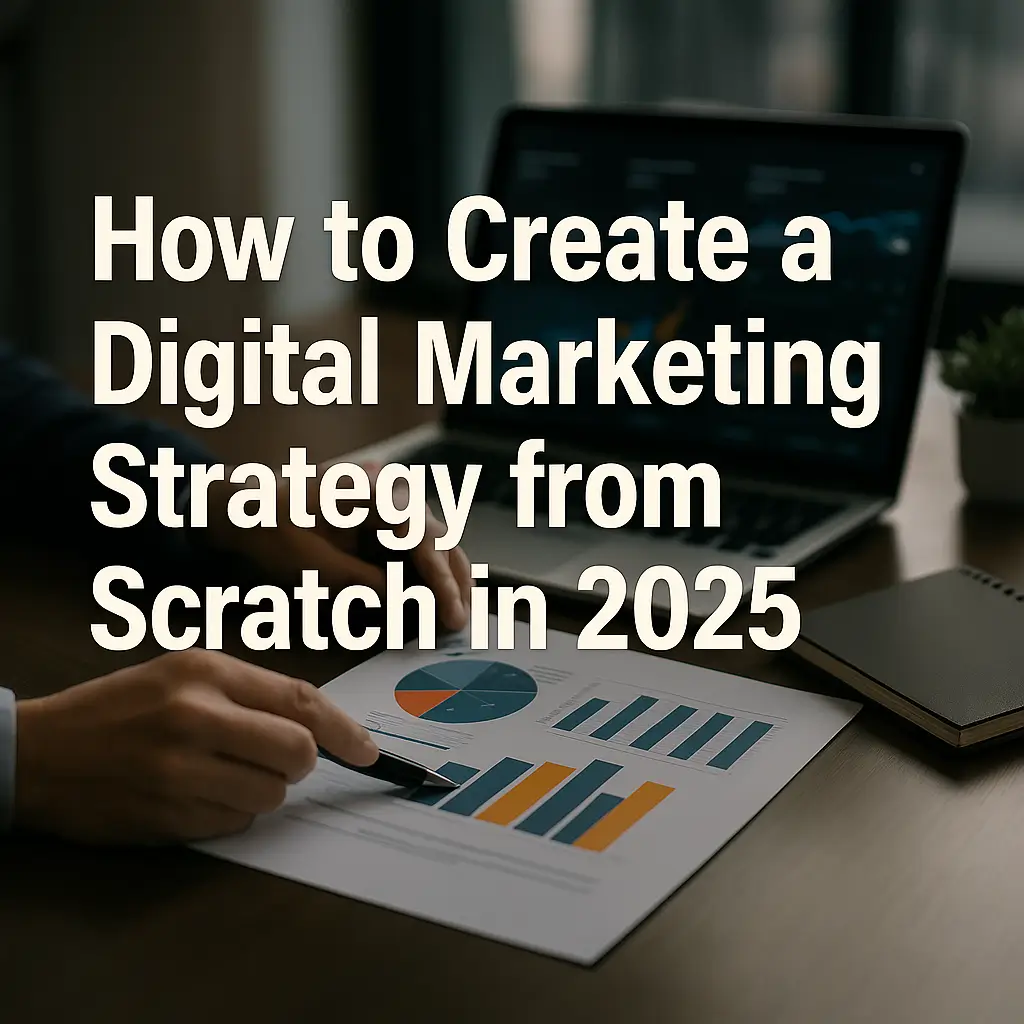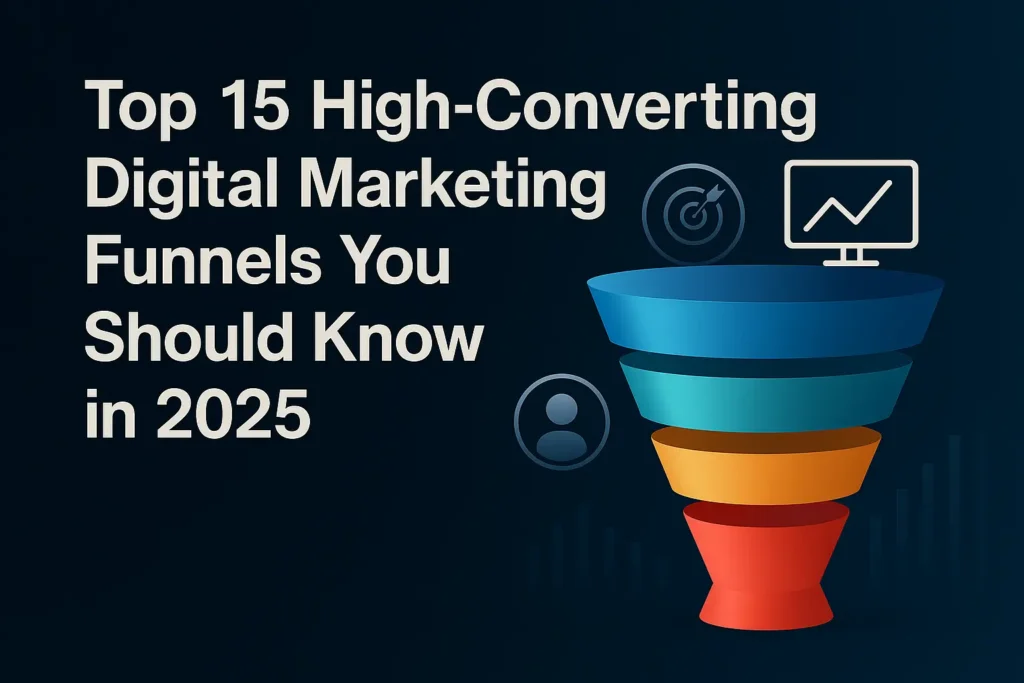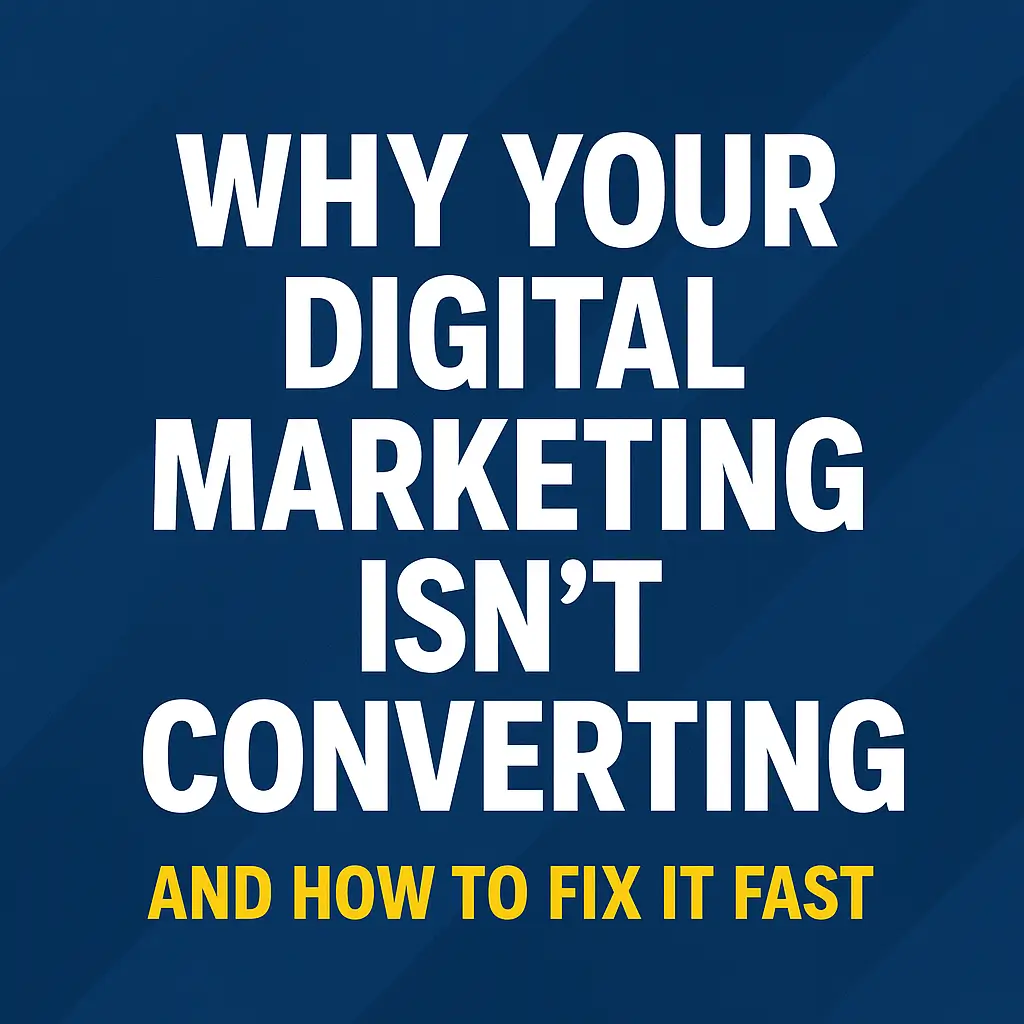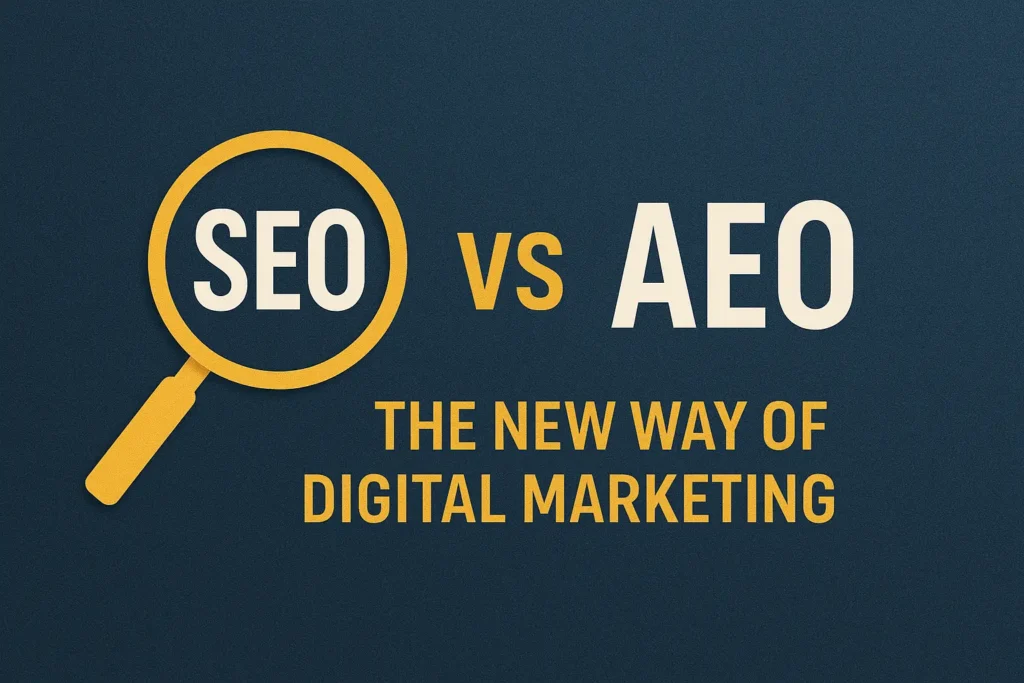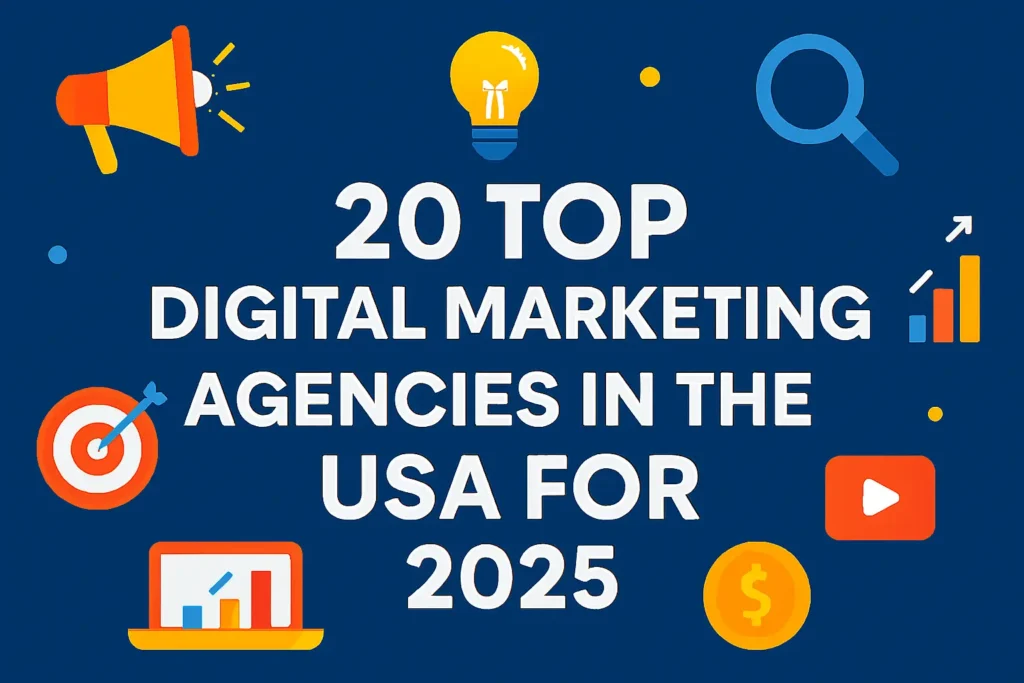This digital marketing glossary was created to help you make sense of the terms that flood the world of online marketing. From CTR and ROAS to SERP, UGC, and beyond — it’s easy to feel overwhelmed, especially if you’re new to the space or wearing multiple hats as a founder or marketer.
Whether you’re searching for SEO terms for beginners, looking to get key marketing terms explained, or just trying to stay sharp on the latest digital marketing terms of 2025 — this glossary is built to give you clear, real-world explanations you can actually use.
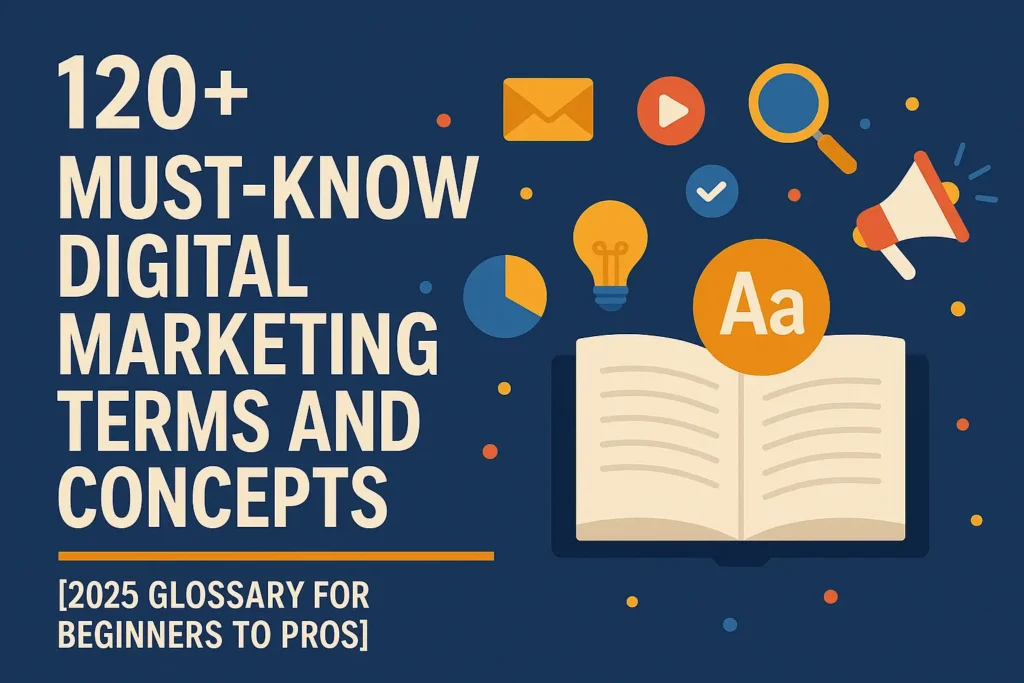
Digital Marketing Terms (with Simple Explanations)
1. AEO (Answer Engine Optimization)
Definition: Optimizing content to directly answer questions users ask in search — especially for AI tools, voice assistants, and Google’s featured snippets.
Why it matters: With more people using ChatGPT, Google SGE, and voice search, AEO helps your content appear as the “final answer.”
Example: Structuring a blog post to clearly answer “How much does SEO cost?” improves AEO and snippet chances.
2. Semantic Search
Definition: Google and AI tools now understand meaning, intent, and context, not just keywords.
Why it matters: Writing keyword-stuffed content no longer works. Semantic SEO focuses on topic depth and related phrases.
Example: If someone searches “best laptop for design,” Google understands they’re likely looking for high-performance specs — not just the keyword “laptop.”
3. EEAT (Experience, Expertise, Authoritativeness, Trustworthiness)
Definition: A Google content quality framework that now includes first-hand experience in 2025 (EEAT instead of just EAT).
Why it matters: Google favors content from real people with real experience. Adding bylines, credentials, and unique insights boosts EEAT.
Example: A product review blog performs better if it includes your photos, opinions, and use cases — not just generic info.
4. SGE (Search Generative Experience)
Definition: Google’s new AI-powered search feature that gives AI-generated summaries at the top of search results.
Why it matters: Content needs to be structured so it feeds into these AI answers — including clear sections, questions, and concise answers.
Example: A blog with subheadings like “What is semantic search?” can be pulled directly into SGE responses.
5. Programmatic SEO
Definition: A method of generating thousands of SEO pages using structured data, templates, and automation.
Used by: Product review sites, marketplaces, SaaS platforms.
Example: Zapier uses programmatic SEO to build hundreds of “How to connect [Tool A] with [Tool B]” pages, all indexed on Google.
6. Topical Authority
Definition: Google’s preference for sites that cover an entire topic in-depth — not just one keyword.
How to build it: Create content clusters around a main topic (pillar + sub-articles).
Example: Instead of 1 article on “Email Marketing,” you create 15 posts covering strategy, tools, list building, automation, segmentation, etc.
7. Content Decay
Definition: The gradual drop in organic traffic when older content becomes outdated, less relevant, or replaced by competitors.
Why it matters: Updating old blogs is now essential to stay ranked.
Example: Your “Best SEO Tools in 2023” post needs a 2025 update or you’ll lose ranking.
8. Zero-Click Search
Definition: When users find what they need directly on the SERP (Google’s answer boxes, SGE, etc.) and don’t click any link.
Why it matters: You still get brand exposure even without a click — but you need to write for snippets, not just clicks.
Example: A bolded answer to “What is bounce rate?” on Google leads to no clicks, but your site is still seen as an authority.
9. Vector Search
Definition: A search method powered by AI and embeddings — used in semantic and conversational search engines.
Why it matters: Content that includes natural language, context, and related terms performs better in vector-based retrieval systems like ChatGPT or Google SGE.
Example: Tools like Pinecone, Weaviate, and OpenAI embeddings use vector search for smarter internal search or recommendations.
10. Personalization Engines
Definition: AI systems that customize user experiences based on behavior, intent, or segmentation.
Used by: SaaS apps, ecommerce sites, and CRMs.
Example: A user visiting your pricing page 3 times gets a personalized chatbot popup offering a demo call or discount.
11. SEO (Search Engine Optimization)
Definition: The process of optimizing your website and content so that it appears higher in search engine results like Google.
Example: Writing a blog post that ranks on page 1 for “best project management tools” is SEO in action.
12. CTR (Click-Through Rate)
Definition: The percentage of users who click on a link, ad, or button after seeing it.
Formula: (Clicks ÷ Impressions) × 100
Example: Your Facebook ad was seen 1,000 times and clicked 50 times. Your CTR = 5%.
13. Bounce Rate
Definition: The percentage of visitors who land on your site and leave without interacting or visiting another page.
Why it matters: A high bounce rate may signal that your content isn’t relevant or engaging.
Example: Someone visits your blog but exits immediately — that’s a bounce.
14. Conversion Rate
Definition: The percentage of users who take a desired action on your site (like signing up, buying, or booking a demo).
Formula: (Conversions ÷ Total Visitors) × 100
Example: If 100 people visit your landing page and 7 sign up for your free trial, your conversion rate is 7%.
15. CPC (Cost Per Click)
Definition: The amount you pay each time someone clicks on your ad in a pay-per-click (PPC) campaign.
Example: If you spent $50 and got 100 clicks, your CPC = $0.50.
16. SERP (Search Engine Results Page)
Definition: The page you see after searching something on Google or Bing. It includes organic results, ads, featured snippets, and more.
Why it matters: Ranking higher on the SERP = more visibility = more traffic.
Example: If your blog shows up as a featured snippet when someone searches “how to write a press release,” you own that SERP spot.
17. Landing Page
Definition: A standalone web page built specifically to convert visitors through a single focused action — like signing up or downloading a guide.
Use case: Used in PPC ads, email campaigns, and sales funnels.
Example: Your “Free Ebook Download” page with just a form and CTA is a landing page.
18. UTM Parameters
Definition: Short tags added to the end of a URL to track where traffic is coming from (useful in Google Analytics).
Example:?utm_source=facebook&utm_medium=cpc&utm_campaign=launch2025
This tells you the visitor came from Facebook Ads for your 2025 launch campaign.
19. ROAS (Return on Ad Spend)
Definition: Measures how much revenue you earn for every dollar you spend on ads.
Formula: Revenue ÷ Ad Spend
Example: If you spend $100 on ads and earn $400 in sales, your ROAS is 4x (or 400%).
20. Lead Magnet
Definition: A free resource or offer (like an ebook, checklist, or free trial) used to capture someone’s contact details, usually in exchange for an email.
Example: “Download our Free SEO Checklist” is a lead magnet offered on a blog to grow your email list.
21. CRO (Conversion Rate Optimization)
Definition: The practice of improving your website or landing pages to increase the percentage of visitors who take a desired action (like signing up, purchasing, or downloading).
Why it matters: Even small tweaks (like button color or form placement) can significantly improve ROI.
Example: Rewriting a landing page headline to be more benefit-driven improves signups by 18%.
22. Retargeting (or Remarketing)
Definition: Showing ads to users who previously visited your site but didn’t convert.
Where it happens: Facebook, Instagram, Google Display Network, LinkedIn.
Example: You visit a sneaker website but don’t buy. Later, you see the same shoes on Instagram. That’s retargeting.
23. Drip Campaign
Definition: A series of pre-written emails automatically sent to a user based on a specific timeline or action.
Why it works: It nurtures leads gradually and keeps them engaged.
Example: After downloading your ebook, a subscriber receives a 5-day email series introducing your product or service.
24. Lead Scoring
Definition: Assigning a numeric value to leads based on how likely they are to convert.
Used in: CRMs like HubSpot, Salesforce, Brevo.
Example: A user who opens 3 emails, visits your pricing page, and books a demo scores higher than someone who just downloaded a guide.
25. MQL & SQL (Marketing Qualified Lead & Sales Qualified Lead)
Definition:
- MQL: A lead who shows interest (downloads, email opens)
- SQL: A lead who shows buying intent (e.g., requests a demo)
Why it matters: Helps sales and marketing teams focus on the right leads at the right stage.
26. Attribution Model
Definition: A method used to assign credit to different marketing channels in a user’s journey.
Common models: First-click, last-click, linear, data-driven.
Example: A customer sees your Instagram ad, then Googles your site, and finally clicks a newsletter link to purchase — which channel gets credit?
27. Lead Nurturing
Definition: Building a relationship with potential customers through helpful, relevant content over time.
Methods: Email, remarketing, chatbots, educational videos.
Example: A SaaS tool sends new leads a 7-day onboarding email series with use-case videos and customer stories.
28. A/B Testing (Split Testing)
Definition: Comparing two versions of a page, email, or ad to see which performs better.
Metrics: CTR, conversion rate, time on page, etc.
Example: Version A has a red CTA button. Version B is green. B converts 12% higher. That’s the winner.
29. Call to Action (CTA)
Definition: A prompt that encourages the user to take a specific action — like “Sign up,” “Download now,” or “Start free trial.”
Why it matters: Strong CTAs guide user behavior and improve conversion.
Example: “Get Your Free SEO Audit Today” is a clearer CTA than “Learn More.”
30. Funnel (Marketing Funnel)
Definition: The step-by-step journey users take from first discovering your brand to becoming a customer.
Phases:
- Top of Funnel (TOFU) – Awareness (blogs, social, SEO)
- Middle (MOFU) – Consideration (case studies, lead magnets)
- Bottom (BOFU) – Decision (free trials, demos, pricing pages)
Example: A user reads your blog → downloads your checklist → attends a webinar → starts a free trial.
31. UGC (User-Generated Content)
Definition: Any content—images, videos, reviews, or posts—created by users or customers, not the brand itself.
Why it works: Builds authenticity and trust.
Example: A customer posts a video using your product and tags your brand. You reshare it on Instagram.
32. Influencer Marketing
Definition: Collaborating with creators who have loyal followers to promote your product or service.
Types: Nano (1k–10k), Micro (10k–100k), Macro (100k–1M+), Celebrity
Example: A skincare brand partners with a beauty YouTuber to showcase their new face serum in a GRWM (Get Ready With Me) video.
33. Engagement Rate
Definition: The percentage of users who interact with your content—likes, shares, comments—relative to your follower or reach count.
Formula: (Engagements ÷ Reach or Followers) × 100
Example: A reel with 2,000 views and 100 likes + comments has a 5% engagement rate.
34. Reels (Instagram Reels)
Definition: Short-form vertical videos on Instagram (similar to TikTok), favored by the algorithm in 2025 for organic reach.
Why it matters: Reels now account for the majority of viral brand content on IG.
Example: A behind-the-scenes 30-second reel of your SaaS team launching a new feature.
35. Social Listening
Definition: Monitoring social media platforms for mentions of your brand, competitors, or related keywords to gather insights.
Tools: Brand24, Sprout Social, Mention.
Example: You find users complaining about a competitor’s feature—you respond with how your tool solves that problem.
36. Hashtag Strategy
Definition: Using relevant, targeted hashtags to increase content visibility and discoverability on platforms like Instagram, LinkedIn, TikTok, and Twitter.
Example: A digital agency posts a design tutorial with #MarketingTips #CanvaTutorial #ContentCreation to reach new users.
37. Social Proof
Definition: A psychological trigger where people follow the actions of others — in marketing, it means showcasing real users, testimonials, reviews, and counts.
Types: Testimonials, case studies, number of users/customers.
Example: “Over 250,000 marketers use our platform” or “As seen in Forbes.”
38. Viral Coefficient
Definition: The number of new users a current user brings in through word-of-mouth or sharing.
Formula: # of invites × conversion rate of those invites.
Why it matters: If each user brings in 1+ new user, your product grows exponentially.
Example: Dropbox’s referral system used viral loops to grow from 100k to millions.
39. Social Commerce
Definition: Buying directly within social platforms like Instagram, TikTok, and Facebook without leaving the app.
Why it matters: Reduces friction = higher conversion.
Example: A TikTok creator uses Shopify’s TikTok Shop integration to sell skincare in-video.
40. Community-Led Growth
Definition: A growth strategy where your customer community (forums, groups, Discords) actively drives product adoption, support, and content creation.
Used by: Notion, Figma, Webflow, and many SaaS tools.
Example: A product’s Reddit group answers new user questions faster than the support team.
41. Marketing Automation
Definition: The use of software to automate repetitive marketing tasks such as email sequences, lead scoring, social media posts, and workflows.
Tools: HubSpot, ActiveCampaign, Brevo, n8n.
Example: When a user signs up, they automatically receive a welcome email, are tagged as a lead, and added to a newsletter sequence — no manual work needed.
42. CRM (Customer Relationship Management)
Definition: A system used to manage customer data, track interactions, manage pipelines, and improve relationships.
Popular CRMs: HubSpot, Salesforce, Zoho, Pipedrive.
Example: A CRM shows that John opened your last three emails, visited the pricing page twice, and booked a call — time to close the deal.
43. Behavioral Segmentation
Definition: Grouping users based on actions they’ve taken — such as pages visited, time spent, clicks, or purchases — instead of just demographics.
Why it matters: Enables personalized targeting and messaging.
Example: A visitor who reads your entire “Pricing” page and downloads a case study should see a demo CTA — not a blog suggestion.
44. Predictive Analytics
Definition: Using machine learning and historical data to forecast future behavior like churn, conversions, or LTV.
Tools: Google Analytics 4, Amplitude, Klaviyo, Adobe Analytics.
Example: A predictive model tells you that users who don’t complete onboarding within 3 days are 60% more likely to churn.
45. Lead Intelligence
Definition: Collecting and analyzing data about leads (like company, behavior, tech stack, or intent) to prioritize outreach.
Tools: Clearbit, Apollo.io, Leadfeeder.
Example: A user from a Fortune 500 company visits your “Enterprise Solutions” page. Your CRM tags this as a high-value lead for sales.
46. Intent Data
Definition: Signals that show a user or business is actively researching or considering a product in your category.
Used by: B2B marketing teams for account-based marketing (ABM).
Example: A SaaS lead reads 5 comparison blogs on your site and visits G2 — strong buying intent.
47. AI Copywriting
Definition: Using artificial intelligence to generate blog posts, ad copy, emails, product descriptions, and landing page content.
Tools: ChatGPT, Jasper, Copy.ai, Writesonic.
Why it matters: Speeds up content creation but must be paired with real human editing to maintain authenticity.
Example: Writing a blog draft with ChatGPT, then refining tone and structure manually.
48. Personalization Tokens
Definition: Variables that dynamically insert user-specific data into emails or web pages.
Example:
- “Hi {first_name}, here’s your 20% discount.”
- “Welcome back, {company_name} team!”
Tools: Klaviyo, Mailchimp, HubSpot.
49. CDP (Customer Data Platform)
Definition: A system that consolidates customer data from all channels into one unified view — used for segmentation, automation, and analysis.
Why it matters: CDPs enable hyper-personalized, omnichannel campaigns.
Tools: Segment, Bloomreach, Tealium.
Example: Your CDP pulls web activity, email clicks, and product usage into one customer profile.
50. Chatbots (AI Chat Support)
Definition: Automated tools that simulate real conversations to answer questions, qualify leads, or provide 24/7 support.
Modern Use: GPT-based bots now handle contextual queries, bookings, and product recommendations.
Example: A visitor asks, “What’s the difference between plans?” — your chatbot explains features, offers a demo, and captures email.
51. Evergreen Content
Definition: Content that stays relevant and continues to bring traffic over time — unlike trend-based or time-sensitive pieces.
Example: “How to Write a Cold Email” will be useful for years, while “Instagram Algorithm Update June 2023” is not.
52. Content Calendar
Definition: A planned schedule for publishing content across channels (blogs, social media, email).
Tools: Notion, Trello, CoSchedule, ClickUp.
Example: Planning 3 blog posts, 2 reels, and 1 newsletter per week for the next 30 days.
53. Content Repurposing
Definition: Reusing and adapting one piece of content into multiple formats.
Example: Turning a long blog post into a LinkedIn carousel, YouTube short, and podcast snippet.
54. Pillar Content
Definition: A long-form, high-value piece of content that covers a broad topic and links to related subtopics (cluster content).
Why it matters: Helps build topical authority and internal linking.
Example: A 3000-word guide on “Content Marketing” that links to posts like “How to Write Headlines,” “Best Tools,” etc.
55. Featured Snippet
Definition: A short summary box at the top of Google’s SERP that answers a query directly — pulled from a web page.
Why it matters: Increases visibility and authority without needing a #1 organic rank.
Example: Your paragraph on “What is A/B Testing?” appears above all other results.
56. Schema Markup (Structured Data)
Definition: Code that helps search engines understand your page’s content and show enhanced results (rich snippets).
Tools: RankMath, Schema.org, Google Tag Manager.
Example: Adding FAQ schema so your blog shows expandable questions in search results.
57. Canonical Tag
Definition: An HTML tag that tells search engines which version of a page is the “master” copy, preventing duplicate content issues.
Example: Used when similar product pages exist with different filters or URLs.
58. DA (Domain Authority)
Definition: A score (0–100) by Moz that estimates a website’s ability to rank in search results based on backlinks and authority.
Note: Not used by Google directly, but still a useful comparative metric.
59. Internal Linking
Definition: Linking from one page or blog post on your site to another, improving SEO and keeping users engaged longer.
Example: Linking from “Email Marketing” blog to “Best Email Subject Lines That Convert.”
60. Anchor Text
Definition: The clickable text in a hyperlink.
SEO Tip: Use descriptive anchor text instead of generic “click here.”
Example: “Learn how to build your content strategy” (✓) vs. “Click here to read” (✗)
61. Meta Description
Definition: A short summary (up to 155–160 characters) that appears below your page title in search results.
Why it matters: Influences click-through rate, even though it’s not a ranking factor.
62. Title Tag (Meta Title)
Definition: The HTML title of your web page, shown in the browser tab and search engines.
Best practice: Include your target keyword early, write under 60 characters, and make it enticing.
63. Alt Text (Image Alt Attribute)
Definition: Describes what’s in an image — used for SEO, accessibility, and screen readers.
Example: Instead of “image1.jpg,” use “Marketing funnel diagram showing TOFU-MOFU-BOFU stages.”
64. LSI Keywords (Latent Semantic Indexing)
Definition: Related phrases and terms that help search engines understand content contextually.
Example: For the keyword “email marketing,” LSI terms might include “open rate,” “subject line,” “campaign automation.”
65. Content Brief
Definition: A detailed outline for a writer or content team that includes the keyword focus, structure, word count, tone, and references.
Why it matters: Ensures consistency, SEO optimization, and quality from the start.
66. Content Audit
Definition: Reviewing and evaluating existing content to improve SEO, update outdated info, merge duplicate pages, or remove low-value content.
Tools: Screaming Frog, Semrush, Ahrefs Content Audit.
Example: Removing 2021 listicles or refreshing old blog posts with updated stats.
67. Long-Form Content
Definition: Articles typically over 1500–2000 words that cover a topic comprehensively.
Why it matters: Often ranks higher in search and provides more value.
Example: “The Ultimate Guide to Google Analytics 4” with screenshots, examples, and FAQs.
68. Content Velocity
Definition: The rate at which new content is published on your site.
Why it matters: A steady publishing pace can signal authority to Google and improve indexing speed.
Example: Publishing 3 high-quality blogs per week vs. 1 per month.
69. Exit Rate
Definition: The percentage of users who leave your website from a particular page — not necessarily the first or only page they visited.
How it differs from Bounce Rate: Bounce is from single-page visits; exit rate tracks all sessions.
Example: If your pricing page has a high exit rate, it may need clearer CTAs.
70. Heatmap
Definition: A visual representation showing where users click, scroll, or move on your website.
Tools: Hotjar, Crazy Egg, Microsoft Clarity.
Example: A heatmap shows users aren’t scrolling below the fold — time to move your CTA higher.
Definition: A long-form video that explains a product or offer in-depth and persuades viewers to take action, often used in funnels or landing pages.
Example: A SaaS tool uses a 3-minute explainer video + testimonial montage to drive signups.
71. VSL (Video Sales Letter)
Definition: A long-form video that explains a product or offer in-depth and persuades viewers to take action, often used in funnels or landing pages.
Example: A SaaS tool uses a 3-minute explainer video + testimonial montage to drive signups.
72. CPM (Cost per Mille / Cost per Thousand Impressions)
Definition: The price of 1,000 ad impressions — a key metric in display and video ads.
Example: If you pay $25 CPM and your ad shows 10,000 times, you’ve spent $250.
73. CPL (Cost per Lead)
Definition: How much you pay to acquire a lead through ads or campaigns.
Example: You run a LinkedIn ad that gets 20 leads for $200. Your CPL = $10.
74. Native Advertising
Definition: Ads that blend into the content or design of the platform they’re shown on — appearing like organic content.
Example: Sponsored articles on news sites or promoted stories on Instagram.
75. Affiliate Marketing
Definition: Earning a commission by promoting another company’s product or service and driving sales or leads.
Example: A blogger earns 20% commission every time someone buys a tool through their affiliate link.
76. Attribution Window
Definition: The time frame during which a conversion is credited to an ad or campaign.
Example: A 7-day attribution window means the user must convert within 7 days of clicking the ad for credit.
77. AIDA Framework
Definition: A classic marketing formula: Attention – Interest – Desire – Action.
Use Case: Used to write copy that moves readers from awareness to decision.
Example:
- Attention: Hook headline
- Interest: Highlight benefits
- Desire: Social proof/testimonials
- Action: Strong CTA
78. Above the Fold
Definition: The part of a web page visible without scrolling.
Why it matters: It’s the first thing users see, and CTRs are usually higher here.
Example: Placing your CTA or lead magnet above the fold increases conversion chances.
79. Conversion Path
Definition: The series of steps or touchpoints a user takes from first interaction to becoming a customer.
Example: Ad → Landing Page → Lead Magnet → Email → Demo → Purchase
80. Scroll Depth
Definition: Measures how far users scroll down a page.
Tools: Hotjar, GA4, Microsoft Clarity
Example: If most users scroll only 30%, your CTA at 80% might never be seen.
81. Retention Rate
Definition: The percentage of users or customers who return or stay active after a certain period.
Why it matters: High retention = lower CAC and stronger lifetime value (LTV).
Example: Your app retains 70% of users after 30 days = strong product engagement.
82. Churn Rate
Definition: The opposite of retention — the percentage of users who stop using your product or unsubscribe over time.
Example: You lost 10 out of 100 paid subscribers in a month. Churn rate = 10%.
83. Ad Fatigue
Definition: When your audience sees the same ad too often and engagement drops.
Fix: Refresh ad creative, try new copy, or retarget with different angles.
Example: Facebook ad CTR drops from 3.2% to 0.8% after 2 weeks = ad fatigue.
84. Split URL Testing
Definition: Testing two completely different web pages (different URLs) against each other instead of just changing elements on one.
Use Case: Great for major layout changes or funnel redesigns.
85. Lead Qualification
Definition: Determining if a lead fits your ideal customer profile and is ready for sales.
Methods: Forms, quizzes, lead scoring, or AI chatbots.
Example: A demo request from a CEO at a relevant company is a qualified lead. A student from another industry is not.
86. Geo-Targeting
Definition: Showing content or ads to users based on their location — country, city, or even postal code.
Example: A local clinic runs Facebook ads only to people within a 10km radius.
87. Dynamic Content
Definition: Content that changes based on who’s viewing it — tailored by behavior, demographics, or preferences.
Example: An ecommerce homepage shows different products to returning customers vs. first-time visitors.
88. Interactive Content
Definition: Content that users can engage with — like quizzes, calculators, polls, sliders, or assessments.
Why it works: Boosts time on page and shares.
Example: “What’s Your Marketing IQ?” quiz that ends with a lead form.
89. Consent Management Platform (CMP)
Definition: Software used to manage user privacy preferences in compliance with GDPR, CCPA, etc.
Why it matters: Collecting cookies or personal data without consent is now a legal risk.
Example: Cookie popups that let users accept or reject tracking.
90. Accessibility (Web Accessibility / WCAG)
Definition: Designing websites so they’re usable by people with disabilities (visual, cognitive, motor).
Why it matters: Legal compliance + better UX for all.
Example: Including alt text, keyboard navigation, contrast ratios, and screen-reader support.
91. Brand Equity
Definition: The perceived value, trust, and recognition a brand holds in the minds of consumers — often reflected in pricing power and loyalty.
Example: Apple’s brand equity allows it to charge premium prices and retain loyal fans.
92. Owned Media
Definition: Any digital asset or platform your brand controls — like your website, email list, app, or blog.
Why it matters: Unlike social platforms, you fully control content and data.
Example: A SaaS company’s blog and newsletter are examples of owned media.
93. Zero-Party Data
Definition: Data that users intentionally and proactively share — such as preferences, interests, or feedback.
Why it matters: It’s highly accurate, consent-based, and privacy-compliant.
Example: A quiz that asks “What type of marketer are you?” and stores user results.
94. AI-Powered Personalization
Definition: Real-time customization of content, recommendations, or UX based on user behavior and AI predictions.
Example: A B2B SaaS homepage changes based on user industry (healthcare vs. finance) using AI.
95. First-Click Attribution
Definition: A model that gives 100% conversion credit to the first touchpoint a customer had with your brand.
When it’s useful: For understanding initial discovery sources.
Example: A customer found you via LinkedIn ad but purchased after 4 emails — first-click gives credit to LinkedIn.
96. Creator Marketing
Definition: Partnering with niche creators (not just influencers) who produce original, trusted content on platforms like YouTube, TikTok, Substack, and LinkedIn.
Why it’s trending: People trust creators more than brands.
Example: A SaaS tool sponsors a creator’s email newsletter or podcast episode.
97. AI Agents / Autonomous Marketers
Definition: AI tools (like Auto-GPT or n8n + GPT chains) that independently plan, execute, and optimize marketing tasks.
Use Case: Automating outreach, campaign planning, or blog writing at scale.
Example: An AI bot that finds trending keywords, writes a draft, and uploads to WordPress.
98. Brand SERP (Search Engine Results Page)
Definition: The results that show up when someone searches your brand name on Google — including site links, reviews, Knowledge Panel, and social accounts.
Why it matters: It’s your brand’s first impression in search.
Optimization: Schema markup, Google Business, consistent branding, and link control.
99. Loyalty Loop
Definition: A customer journey model where satisfied users re-enter the funnel — becoming repeat buyers or advocates without starting over.
Example: A customer who finishes onboarding → loves your product → joins your referral program and brings in 3 new leads.
100. Customer Lifetime Value (CLTV or LTV)
Definition: The total revenue you can expect from a single customer over their entire relationship with your business.
Formula: (Avg. Purchase Value) × (Avg. Purchase Frequency) × (Avg. Customer Lifespan)
Example: A user pays $50/month for 2 years = $1,200 LTV.
101. Lead Magnet
Definition: A free, valuable resource offered in exchange for a user’s contact information (usually email).
Examples: eBooks, templates, checklists, webinars, cheat sheets.
Why it works: It kickstarts the lead generation funnel.
Example: “Download our free 2025 Content Calendar Template” in exchange for email signup.
102. Squeeze Page
Definition: A type of landing page designed solely to capture a visitor’s email address (or other data) through a lead magnet.
Features: Minimal distractions, single CTA, persuasive headline.
Example: A 1-page layout with a free guide offer and form above the fold.
103. Micro-Conversion
Definition: Small actions that indicate user interest but aren’t final goals.
Examples: Clicking a CTA, watching 50% of a video, downloading a checklist.
Why it matters: Helps analyze and improve funnel performance step-by-step.
104. Sales Funnel
Definition: The visual model of the customer journey from awareness to conversion.
Stages: TOFU (Top of Funnel), MOFU (Middle), BOFU (Bottom).
Example: Visitor reads a blog → downloads checklist → attends webinar → signs up for trial → becomes a customer.
105. Funnel Abandonment
Definition: When users drop off before completing a conversion within your sales funnel.
Fix: Reduce steps, add trust elements, use retargeting.
Example: 1,000 visits → 200 download the guide → only 10 attend the webinar. Abandonment = 98% from TOFU to BOFU.
106. Landing Page Optimization (LPO)
Definition: Improving your landing pages to increase conversions using testing, copy changes, UX updates, and visuals.
Tools: Unbounce, Instapage, Hotjar.
Example: Changing headline + adding testimonials boosts conversion from 9% to 13%.
107. Double Opt-In
Definition: A lead generation practice where a user confirms their subscription through a verification email.
Why use it: Reduces fake signups and improves email deliverability.
Example: After form submission, user must click the link in their inbox to join your list.
108. Exit-Intent Popup
Definition: A popup that appears when a visitor’s mouse movement suggests they’re about to leave the page.
Use Case: Capture abandoning users with last-minute offers or lead magnets.
Example: “Wait! Don’t leave. Grab our free 20% coupon!”
109. Referral Marketing
Definition: Encouraging existing customers to refer others, often through rewards or discounts.
Examples: “Give $10, Get $10” offers, affiliate links, shareable discount codes.
110. Growth Loop
Definition: A self-sustaining system where each new user helps bring in additional users.
Example: Dropbox gives storage for referrals → new users also refer → loop continues.
111. Cold Outreach
Definition: Reaching out to potential leads who haven’t interacted with your brand yet — via email, LinkedIn, or cold calling.
Tools: Instantly.ai, Lemlist, Hunter.
Example: A cold email offering a free SEO audit to a marketing director.
112. Search Intent Optimization
Definition: Tailoring your content to match what users are actually trying to find (informational, navigational, transactional).
Why it works: Aligning with intent improves rankings and clicks.
Example: For “best CRM for startups,” users want comparisons, not definitions.
113. Zero-Click Search
Definition: A search result where users get their answer without clicking any website — like featured snippets or instant answers.
Challenge: Brands must optimize to still earn brand exposure and trust.
Solution: Create “position 0” content that answers clearly and links contextually.
114. Zero-Click Content
Definition: Content made to deliver full value without needing a click — often used on LinkedIn, Twitter, or email.
Why it’s powerful: Builds trust, authority, and engagement without redirecting users.
Example: A LinkedIn post that gives a full tutorial without linking to a blog.
115. People Also Ask (PAA)
Definition: A feature on Google SERPs that expands into related questions users commonly ask.
Why it matters: Shows what topics you should address in your content.
Tip: Include these Q&As in your blog posts using FAQ schema.
116. Entity-Based SEO
Definition: Optimizing around topics and context (entities), not just keywords.
Why it matters: Google now understands meaning via knowledge graphs and relationships.
Example: Writing about “HubSpot” means also including CRM, marketing automation, and inbound methodology.
117. Dark Social
Definition: Website traffic and content shares that come from private channels (like WhatsApp, Slack, email, or DMs) that are not trackable by traditional analytics tools.
Why it matters: A large chunk of shares and traffic might be coming from invisible sources — making it harder to measure campaign performance.
Example: A blog post goes viral, but Google Analytics shows “Direct Traffic” because users shared it on WhatsApp or inside a private Slack group.
How to respond: Use share tracking links, branded short links, or qualitative feedback (e.g., “Where did you hear about us?” forms).
118. Impression Share
Definition: The percentage of total available ad impressions your ad actually received.
Formula: Impressions ÷ Eligible Impressions
Example: If you could appear 10,000 times but only did 6,000 → 60% impression share.
119. FOMO (Fear of Missing Out)
Definition: A psychological trigger used in marketing to encourage action through urgency or scarcity.
Examples: “Only 2 spots left!” or “Offer expires in 3 hours.”
120. Scarcity Principle
Definition: A behavioral concept where limited availability increases perceived value.
Example: “Limited to the first 100 buyers” increases urgency.
121. Decoy Effect
Definition: A pricing strategy where a third, less attractive option influences buyers to choose a more profitable one.
Example:
- Basic – $10
- Pro – $25
- Premium – $26
→ Pro looks like the best deal compared to Premium.
122. AI Detection Tools
Definition: Tools that analyze content to detect if it was AI-generated.
Use Case: Avoiding penalization in SEO or ensuring content sounds human.
Tools: Originality.ai, Copyleaks, Content at Scale.
123. AI Writing Assistants
Definition: AI tools that help write content, headlines, ads, emails, and even full articles.
Popular Tools: ChatGPT, Jasper, Writesonic, GrammarlyGO.
Example: ChatGPT drafts a blog post outline. Human then edits and refines tone.
124. Personal Brand
Definition: The intentional creation and promotion of your public identity online — through content, tone, expertise, and values.
Example: Neil Patel and Rand Fishkin are strong personal brands in marketing.
125. Behavioral Email Triggers
Definition: Emails sent based on a user’s actions, such as site visits, link clicks, or inactivity.
Example: A user visits your pricing page 3 times → they receive an automated email with a case study and demo invite.

